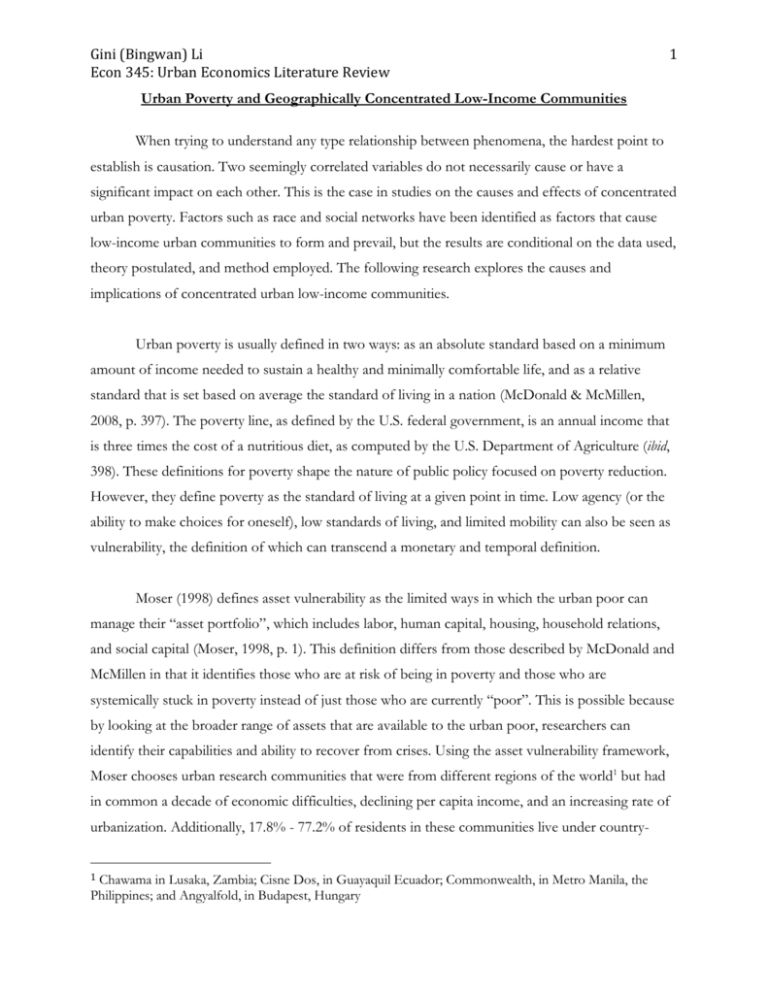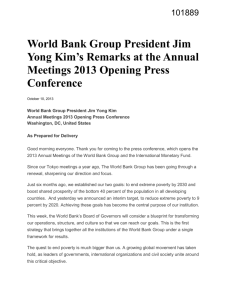Li_Gini-Lit_Review_Revised
advertisement

Gini (Bingwan) Li Econ 345: Urban Economics Literature Review 1 Urban Poverty and Geographically Concentrated Low-Income Communities When trying to understand any type relationship between phenomena, the hardest point to establish is causation. Two seemingly correlated variables do not necessarily cause or have a significant impact on each other. This is the case in studies on the causes and effects of concentrated urban poverty. Factors such as race and social networks have been identified as factors that cause low-income urban communities to form and prevail, but the results are conditional on the data used, theory postulated, and method employed. The following research explores the causes and implications of concentrated urban low-income communities. Urban poverty is usually defined in two ways: as an absolute standard based on a minimum amount of income needed to sustain a healthy and minimally comfortable life, and as a relative standard that is set based on average the standard of living in a nation (McDonald & McMillen, 2008, p. 397). The poverty line, as defined by the U.S. federal government, is an annual income that is three times the cost of a nutritious diet, as computed by the U.S. Department of Agriculture (ibid, 398). These definitions for poverty shape the nature of public policy focused on poverty reduction. However, they define poverty as the standard of living at a given point in time. Low agency (or the ability to make choices for oneself), low standards of living, and limited mobility can also be seen as vulnerability, the definition of which can transcend a monetary and temporal definition. Moser (1998) defines asset vulnerability as the limited ways in which the urban poor can manage their “asset portfolio”, which includes labor, human capital, housing, household relations, and social capital (Moser, 1998, p. 1). This definition differs from those described by McDonald and McMillen in that it identifies those who are at risk of being in poverty and those who are systemically stuck in poverty instead of just those who are currently “poor”. This is possible because by looking at the broader range of assets that are available to the urban poor, researchers can identify their capabilities and ability to recover from crises. Using the asset vulnerability framework, Moser chooses urban research communities that were from different regions of the world1 but had in common a decade of economic difficulties, declining per capita income, and an increasing rate of urbanization. Additionally, 17.8% - 77.2% of residents in these communities live under country1 Chawama in Lusaka, Zambia; Cisne Dos, in Guayaquil Ecuador; Commonwealth, in Metro Manila, the Philippines; and Angyalfold, in Budapest, Hungary Gini (Bingwan) Li Econ 345: Urban Economics Literature Review 2 specific poverty lines (ibid, p. 6). This context provides Moser with information on how vulnerable communities use consumption modifying or income generating strategies to cope with declining real income. The findings show that when households became “poorer”, more women and children join the work force and men migrate to generate remittances. Although this increases a household’s labor asset, it also diminishes its household relations asset, as many children grow up without a paternal figure and family relationships weaken. Increasing a family’s immediate labor asset also erodes its human capital asset, as children are sacrificing their educations for low skill labor. This increases overall vulnerability within a household because it perpetuates poverty from one generation to the next (ibid, p. 9). Moser also found that the human capital asset is largely dependent on economic and social infrastructure provision by local governments. As households earn less income, they substitute more private goods and services for public ones. Household heads’ education level was strongly correlated to household income level. This means that if the public provision of education in times of economic downturn diminishes, the asset vulnerability or urban poor populations also increases. In terms of housing, not having tenure security and legal titles to property made households extremely vulnerable in times of crisis. Not only did they not have incentives to upgrade their homes, but also they were unable to productively generate rent-income from their properties (ibid, 10). This produces a relatively transient population, which can affect human capital development and social capital by weakening social ties and investment in a community. The regulatory environment has a large impact on how households can maximize their housing asset. Similarly, Moser evaluates the tradeoffs inherent in optimizing the household relations asset, as well as the social capital asset. Her study highlights a problem with the traditional definition of poverty; although a family might not be traditionally below the poverty line (for example, if children are generating income), it can still be vulnerable and cut off from economic and social mobility. However, for a government agency, the amount of resources necessary to evaluate households based on asset vulnerability is significantly higher than the amount of resources it takes to measure income. This raises the question of whether public policy should target poverty as defined by income or vulnerability as defined by capabilities. Gini (Bingwan) Li Econ 345: Urban Economics Literature Review 3 Although Moser sees poverty as the consequence of necessary trade-offs between interrelated capabilities, other scholars see more linear causes and solutions to urban poverty. For example, one study attempts to uncover the effect of racial segregation on urban poverty in Canada. Although low-income areas in cities are positively correlated with a high concentration of minority residents, it is unclear whether this is a causal relationship. Walks and Bourne (2006) use census tract files for the 1991 and 2001 census of Canada to identify “visible minorities”2. With this data, Walks and Bourne then classify neighborhoods in Canadian metropolitan areas as isolated host communities (with less than 20% visible minorities), non-isolated host communities (between 20% and 50% visible minorities), pluralism/assimilation enclaves (from 50% to 70% visible minorities), mixed-minority neighborhoods (greater than 70% visible minorities, but no dominant minority), polarized enclaves (greater than 70% visible minorities and over 2/3 of population comes from the same minority), and ghettos (same as polarized enclave with additional criterion that at least 30% of all members of that minority in the urban area must live in the same neighborhood). The purpose of these distinctions is to isolate ghettos, in which minorities are forced into by the host community through discrimination, from minority enclaves, in which minorities choose to strategically live with other people from the same ethnic background. Traditionally, when immigrants arrive in Canada, they will locate in areas with high concentrations of their minority group for support services. However, as they start assimilating in the host culture, they will move to suburbs and decentralize (ibid, p. 276). This leads the authors to conclude that minorities who stay in concentrated urban minority communities are not there by choice, but are rather trapped there because of external forces. To test this theory, they use ordinary least squares regression models that use census tract data for the most segregated metropolises. The independent variables are the proportion of each minority group, the proportion that immigrated to Canada between 1991 and 2001 (recent immigrants), neighborhood type (as defined above), and the type of apartment housing stock (ibid, p. 281). Ultimately, the study did not find that Canadian cities have ghettos, as defined above, despite high levels of spatial segregation in some of Canada’s largest cities. This is because there isn’t one dominant minority in low-income areas inhabited by visible minorities, but rather a few visible 2 Which includes Chinese, South Asians, Blacks, Latin Americans, Lebanese/Arabs/West Asians, and Aboriginals Gini (Bingwan) Li Econ 345: Urban Economics Literature Review 4 minorities that co-inhabit an ethnic community. Further study could elucidate whether these ethnic communities are formed because of social exclusion or by choice. However, the authors did confirm that low income was strongly correlated with certain minority groups, such as Aboriginals, blacks, and Latin Americans (ibid, p. 294). Additionally, it seems that certain types of housing stock, lowincome residents, and minorities are highly correlated, with a huge poor minority population residing in high-rise apartments. This probably has an impact on the social capital that Moser mentioned, but more research is needed to verify this. Ludwig et al. (2001) also explore the role of living environments in how poverty affects juvenile crime. The purpose of their study is to uncover the extent to which spatial concentration of low-income families in high-poverty and high-crime urban neighborhoods affects the criminal activities of youth. One explanation for how high-poverty neighborhoods can affect the rate of crime among youth is that they can depress the opportunity costs of crime by restricting access to quality schools, jobs, and role models (Ludwig, Duncan, & Hirschfield, 2001, p. 656). This study tests this theory with data from the U.S. Department of Housing and Urban Development’s Moving to Opportunity (MTO) experiment, which has assigned 638 families from high-poverty Baltimore neighborhoods into three treatment groups (ibid, p. 656). Unlike the previous two studies, which observe natural phenomena in urban environments, this study has a controlled experiment that has less outside influence. The MTO participants are broken down into three groups: the experimental group, the section-8 comparison group, and the control group. The experimental group receives housing subsidies, counseling, and search assistance in relocating to low poverty areas (less than 10% poverty rate) and private housing markets. The section-8 comparison group receives the same as the experimental group, but with no limitation on where they can relocate. The control group receives no aid. The families chosen for this program entered the program voluntarily, which might bias the results. Additionally, almost all of the MTO households are headed by African-American women, who prioritized escaping from gangs and drugs as primary motivators for enrolling in the program. There are 336 teens in the study that are between the ages of 11 and 16. The independent variable in this experiment is the poverty-rate in a low-income family’s neighborhood. The dependent variable is juvenile crime from these families, which is measured through juvenile arrest records. The results show that up to 14 quarters after relocation, teens in the experimental group have significantly smaller violent-crime arrest rates (75 versus 250) but slightly Gini (Bingwan) Li Econ 345: Urban Economics Literature Review 5 higher property-crime arrest rates (300 versus 50). Possible sources of error for this study include the differences in police action in various locales and different risk-reward ratios for violent and property crimes in various locales. For example, gang involvement was probably more common in areas with high-crime and high-poverty rates, increasing the risk of not joining a gang. Additionally, in low poverty areas, there is probably more expensive property to steal and fewer people watching, driving up the reward in risk-reward analyses. In general, this study shows that environment does seem to have a positive impact on the violent crime rate for children in low-income families. While Moser provides a general framework for understanding poverty, Walks and Bourne, and Ludwig et al. evaluate the implications of poverty’s spatial distribution. They both explore the impact of decentralized poverty, but do not go into more detail about the pathway through which poverty decentralization affects the vulnerabilities of the poor. Is it through social assimilation or better public services that the poor can reduce their vulnerabilities? And if so, can one assume that spatial decentralization actually promotes access to better social networks or better public services? These questions would be great topics for further research. Gini (Bingwan) Li Econ 345: Urban Economics Literature Review Works Cited Ludwig, J., Duncan, G. J., & Hirschfield, P. (2001, May). Urban Poverty and Juvenile Crime: Evidence from a Randomized Housing-Mobility Experiment. The Quarterly Journal of Economics , 655-679. McDonald, J. F., & McMillen, D. P. (2008). Urban Economics and Real Estate. Oxford: Blackwell Publishing. Moser, C. O. (1998). The Asset Vulnerability Framework: Reassessing Urban Poverty Reduction Strategies. World Development , 26 (1), 1-19. Walks, A., & Bourne, L. S. (2006). Ghettos in Canada's cities? Racial Segregation, ethnic enclaves and poverty concentration in Canadian urban areas. The Canadian Geographer , 273-297. 6








